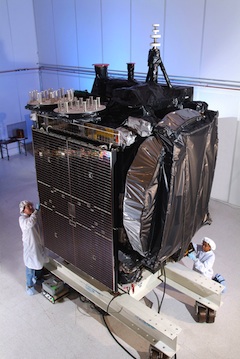Intelsat Regains Control Of Galaxy 15 'Zombie' Satellite
Intelsat in late December re-established control over Galaxy 15 -- about nine months after the operator lost contact with the so-called "zombie" satellite -- and may be able to put it back in service as early as next month.
On April 5, 2010, Galaxy 15 stopped responding to ground controllers because of what now appears to be a problem with the firmware in its telemetry and commanding subsystems, Intelsat vice president of satellite operations and engineering Toby Nassif said in a teleconference with reporters Thursday.
On Dec. 23, the C-band satellite lost power after it went off-orbit, because its solar arrays were no longer pointed to the sun and the battery depleted. At that point it rebooted and Intelsat was able to control the satellite and recharge its batteries.
"We have confirmed the best-case scenario... and we have recovered full functionality," Nassif said.
Galaxy 15 is currently at orbital slot 93 West, where it is undergoing additional testing. After that is completed, the satellite will be moved to either 133 West or 129 West, with the position to be determined based on business needs, Nassif said.

Intelsat is aiming for Jan. 31 to complete testing and would potentially be able to return Galaxy 15 into commercial operation at that time, vice president of corporate communications and investor relations Dianne VanBeber said.
In April 2010 Intelsat moved Galaxy 15 customers to Galaxy 12, the designated in-orbit backup satellite, without any significant service disruption. Broadcast and cable programmers currently on Galaxy 12 include Starz Entertainment, Fox Sports, Rainbow Media, Turner Broadcasting System, HBO, ESPN and NBC Universal.
The smarter way to stay on top of the multichannel video marketplace. Sign up below.
The issue was that during the period Galaxy 15 was out of control, it was still transmitting its payload and thus potentially disrupting nearby satellites. Over the course of 2010, Galaxy 15 successfully completed fly-bys of 15 satellites -- including SES World Skies' AMC-1, AMC-11, AMC-18 and SES-1 -- with minimal interference.
Currently Intelsat is working with the satellite manufacturer, Orbital Sciences, to determine the exact cause of the problem and ensure that measures are in place to prevent similar problems with other Star-2 spacecraft in its fleet.
While initial news reports speculated that solar flares last April may have knocked out Galaxy 15, Intelsat's initial review determined that wasn't the problem. "That's not to say what happened is not related to the harshness of operating in space... but a direct correlation to a solar flare has not been made," Nassif said.
As for costs incurred in dealing with Galaxy 15, Intelsat said its employees had invested thousands of hours but that the ultimate operational cost was less than $1 million. "It's amazing how little collateral damage there has been from this event," VanBeber said.
Galaxy 15 was launched Oct. 13, 2005, and is expected to remain in service until 2022.
